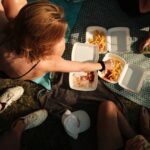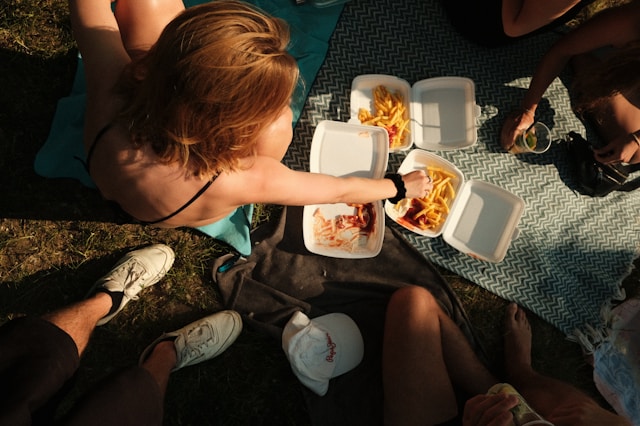Instant Ramen With Peanut Butter and Veggies
Instant ramen is one of the cheapest and easiest meals to prepare on the trail, making it a staple for budget-conscious backpackers. By adding a spoonful of peanut butter and some dehydrated vegetables, you significantly boost the protein and nutritional value of this classic. The result is a warm, savory, and calorie-rich dish that’s quick to cook and easy to pack.
Couscous With Spices and Tuna
Couscous is a lightweight, no-fuss grain that only needs hot water to rehydrate, making it ideal for multiday hikes. Add a packet of tuna and a drizzle of olive oil, then season with garlic, salt, and pepper for a complete, protein-packed meal. This simple combination is cheap, satisfying, and ready in minutes with minimal cleanup.
Instant Mashed Potatoes With Cheese and Bacon Bits
Instant mashed potatoes are a great trail food that’s both filling and comforting after a long hike. Enhance the flavor and calorie content by mixing in shelf-stable bacon bits, cheese powder, or powdered milk. This warm, creamy dish is inexpensive, easy to make, and perfect for cold evenings in the backcountry.
Oatmeal With Peanut Butter and Dried Fruit
Oatmeal is a classic breakfast option for hikers because it’s lightweight, affordable, and energizing. A scoop of peanut butter adds healthy fat and protein, while dried fruits like raisins or apricots provide natural sweetness and fiber. This simple breakfast will keep you full and fueled for the day ahead without draining your food budget.
Rice and Beans With Taco Seasoning
Rice and beans are a time-tested combination for budget meals, and they translate perfectly to backpacking with instant rice and dehydrated beans. Adding taco seasoning brings flavor and variety, while the meal itself is loaded with complex carbs and protein. It’s an affordable, satisfying option that can be customized with hot sauce or salsa packets.
Pasta With Powdered Tomato Sauce and Olive Oil
Budget-friendly pasta dishes can be just as satisfying on the trail as at home. Use quick-cook pasta, mix in powdered tomato sauce, sprinkle dried herbs, and add olive oil for richness. This meal is easy to make, cheap to assemble, and can be elevated with shelf-stable protein like sausage or canned fish.
Tortilla Wraps With Nut Butter and Honey
Tortillas are a long-lasting and versatile food choice for hiking trips. Spread them with peanut or almond butter and drizzle with honey for a sweet, energy-packed meal that requires no cooking. It’s a favorite among backpackers for its simplicity, affordability, and portability—perfect for lunch or a trail snack.
DIY Trail Mix and Energy Balls
Pre-packaged snacks can be expensive, but homemade trail mix and energy balls are a budget-friendly alternative. Combine bulk nuts, seeds, dried fruit, and chocolate chips for a custom mix, or make energy balls with oats, peanut butter, and honey. These snacks are calorie-dense, easy to carry, and cheaper when made in bulk before your trip.
Dehydrated Soup With Crackers or Noodles
Instant soup packets are lightweight, comforting, and easy to prepare with just hot water. Pair them with instant noodles or hearty crackers to make a more filling meal. Look for varieties with vegetables or protein, and consider adding shelf-stable extras like cheese or cured meats to boost nutrition while keeping costs low.
Polenta With Parmesan and Herbs
Instant polenta is a lesser-known but excellent trail food—quick to cook, very filling, and affordable. Mix it with dried herbs, powdered cheese, or olive oil for a savory, satisfying dish. It’s an especially good option for dinner, offering a warm, carb-rich meal that helps replenish energy after a demanding day on the trail.
Absolutely! Here are 5 FAQs to complete your article “Cheap Backpacking Food: 10 Budget Meals for Multiday Hikes”, each with a concise and informative answer:
FAQs
1. How do I keep backpacking meals cheap without sacrificing nutrition?
Stick to high-calorie, low-cost staples like oats, rice, pasta, peanut butter, and dried beans. Add flavor and nutrients using bulk spices, powdered sauces, and dehydrated vegetables. Planning ahead and buying in bulk also helps you balance nutrition and budget.
2. Can I prepare budget backpacking meals without a stove?
Yes, many meals like peanut butter wraps, trail mix, and couscous with tuna can be made without cooking. Cold-soaking oats or couscous in a sealable container is a popular no-cook method that saves fuel and weight.
3. How much food should I bring for a multiday hike?
A general rule is to pack 2,500–4,000 calories per day, depending on the difficulty of your hike and your body’s needs. Choose calorie-dense foods to save space and weight, and portion meals in advance to avoid overpacking or running short.
4. Are there any foods I should avoid bringing on a hike?
Avoid fresh produce, dairy, or anything that spoils quickly in heat. Stick with shelf-stable, non-perishable items like dehydrated foods, nuts, dried fruit, and cured meats. Always test new foods before your trip to ensure they sit well with you on the trail.
5. What’s the cheapest way to buy backpacking food?
Buy dry goods like oats, pasta, and rice in bulk from warehouse stores or local markets. Look for deals online, use dollar stores for basics like ramen and crackers, and make DIY mixes at home. This strategy can cut your food costs by half or more.











